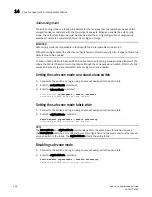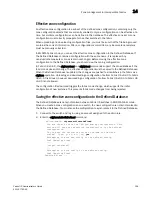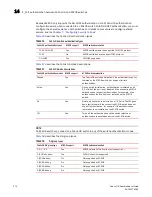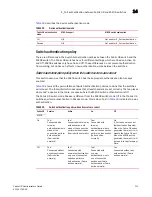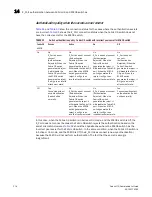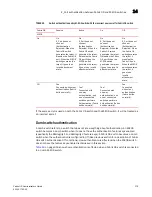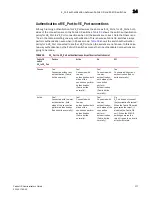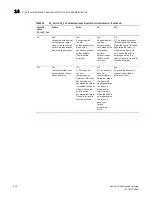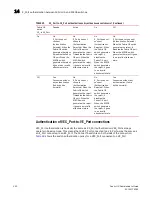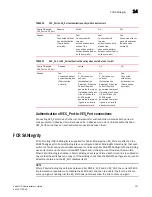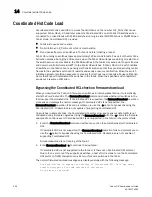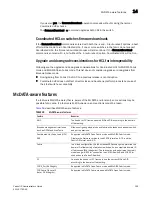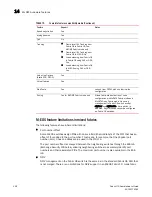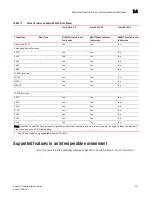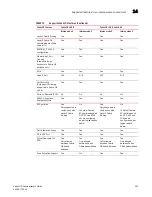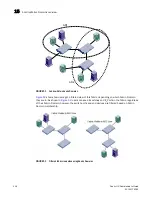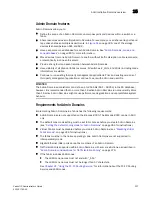
322
Fabric OS Administrator’s Guide
53-1001763-02
FCR SANtegrity
14
FCR implements a simplified version of Fabric Binding that is passive and only checks whether its
own Front Port domain ID and WWN pair is present in the Fabric Binding list that is sent from an
M-EOS switch.
CAUTION
In FOS-only McDATA Fabric Mode fabrics that have Fabric Binding activated, fabric disruptions
may occur if there are any FOS switches that do not have insistent domain ID enabled.
Fabric Binding activation or deactivation is a fabric-wide event. Unlike Layer 2 SANtegrity, FCR
requires additional configurations that you must perform from the command line before
configuring and enabling Fabric Binding using DCFM. You must configure the preferred domain ID.
Fabric Binding behavior in a mixed fabric
The front port preferred domain ID behaves as insistent while Fabric Binding is enabled. Fabric
Binding must be disabled while the EX_Port is part of the edge fabric prior to removing an EX_Port
from a bound fabric to disable the Insistent Domain ID behavior on that EX_Port. Failure to do this
results in Insistent Domain ID behavior of the EX_Port even if it is subsequently connected to an
edge fabric that is not using Fabric Binding.
M-EOS Fabric Binding uses a list made up of domain ID and WWN pairs. Because the FCR front port
WWN cannot be predetermined, you must connect the FCR to the M-EOS edge switch before the
Fabric Binding List can be filled in with the FCR front port domain ID and WWN entry. If you
downgrade to a Fabric OS version that does not support SANtegrity interoperability without first
disabling Fabric Binding, the ports will segment upon subsequent initialization.
When an FC router is attached through an EX_Port to an edge fabric, it creates a translate domain
in the fabric corresponding to the remote edge fabrics with active logical storage area networks
(LSANs) defined. In this case:
•
Translate domains that are already present before Fabric Binding is enabled must be included
in the Fabric Binding List created using DCFM.
•
Translate domains that are created after Fabric Binding is enabled do not have to be added to
the Fabric Binding List and do not cause any Fabric Binding checks to fail. If Fabric Binding is
subsequently disabled, these translate domains must be added to the Fabric Binding List
before Fabric Binding can be re-enabled.
Translate domains do not have Preferred or Insistent Domain ID behavior.
Configuring the preferred domain ID and the insistent domain ID
The preferred domain ID must be configured in order for Fabric Binding to work even if it matches
the default value. The configured preferred domain ID becomes insistent whenever Fabric Binding
is enabled. If the EX_Port is part of the edge fabric, Fabric Binding must be disabled before you can
remove the EX_Port from the Fabric Binding to be able to disable the Insistent Domain ID (IDID).
NOTE
In McDATA Open Fabric mode, it is possible to configure a preferred domain ID outside of the range
allowed for an M-EOS switch. The preferred domain ID must be configured in the range of 97-127 in
Open Fabric mode or Fabric Binding fails to activate.
Содержание 53-1001763-02
Страница 1: ...53 1001763 02 13 September 2010 Fabric OS Administrator s Guide Supporting Fabric OS v6 4 0 ...
Страница 4: ...iv Fabric OS Administrator s Guide 53 1001763 02 ...
Страница 24: ...xxiv Fabric OS Administrator s Guide 53 1001763 02 ...
Страница 28: ...xxviii Fabric OS Administrator s Guide 53 1001763 02 ...
Страница 32: ...xxxii Fabric OS Administrator s Guide 53 1001763 02 ...
Страница 40: ...xl Fabric OS Administrator s Guide 53 1001763 02 ...
Страница 42: ...2 Fabric OS Administrator s Guide 53 1001763 02 ...
Страница 54: ...14 Fabric OS Administrator s Guide 53 1001763 02 High availability of daemon processes 1 ...
Страница 74: ...34 Fabric OS Administrator s Guide 53 1001763 02 Basic connections 2 ...
Страница 102: ...62 Fabric OS Administrator s Guide 53 1001763 02 Audit log configuration 3 ...
Страница 156: ...116 Fabric OS Administrator s Guide 53 1001763 02 The authentication model using RADIUS and LDAP 5 ...
Страница 214: ...174 Fabric OS Administrator s Guide 53 1001763 02 Management interface security 7 ...
Страница 228: ...188 Fabric OS Administrator s Guide 53 1001763 02 Brocade configuration form 8 ...
Страница 276: ...236 Fabric OS Administrator s Guide 53 1001763 02 Creating a logical fabric using XISLs 10 ...
Страница 404: ...364 Fabric OS Administrator s Guide 53 1001763 02 ...
Страница 440: ...400 Fabric OS Administrator s Guide 53 1001763 02 Performance data collection 17 ...
Страница 464: ...424 Fabric OS Administrator s Guide 53 1001763 02 Disabling bottleneck detection on a switch 18 ...
Страница 480: ...440 Fabric OS Administrator s Guide 53 1001763 02 F_Port masterless trunking 19 ...
Страница 494: ...454 Fabric OS Administrator s Guide 53 1001763 02 Buffer credit recovery 20 ...
Страница 560: ...520 Fabric OS Administrator s Guide 53 1001763 02 Port indexing on the Brocade DCX 4S backbone C ...
Страница 574: ...534 Fabric OS Administrator s Guide 53 1001763 02 Hexadecimal overview E ...

